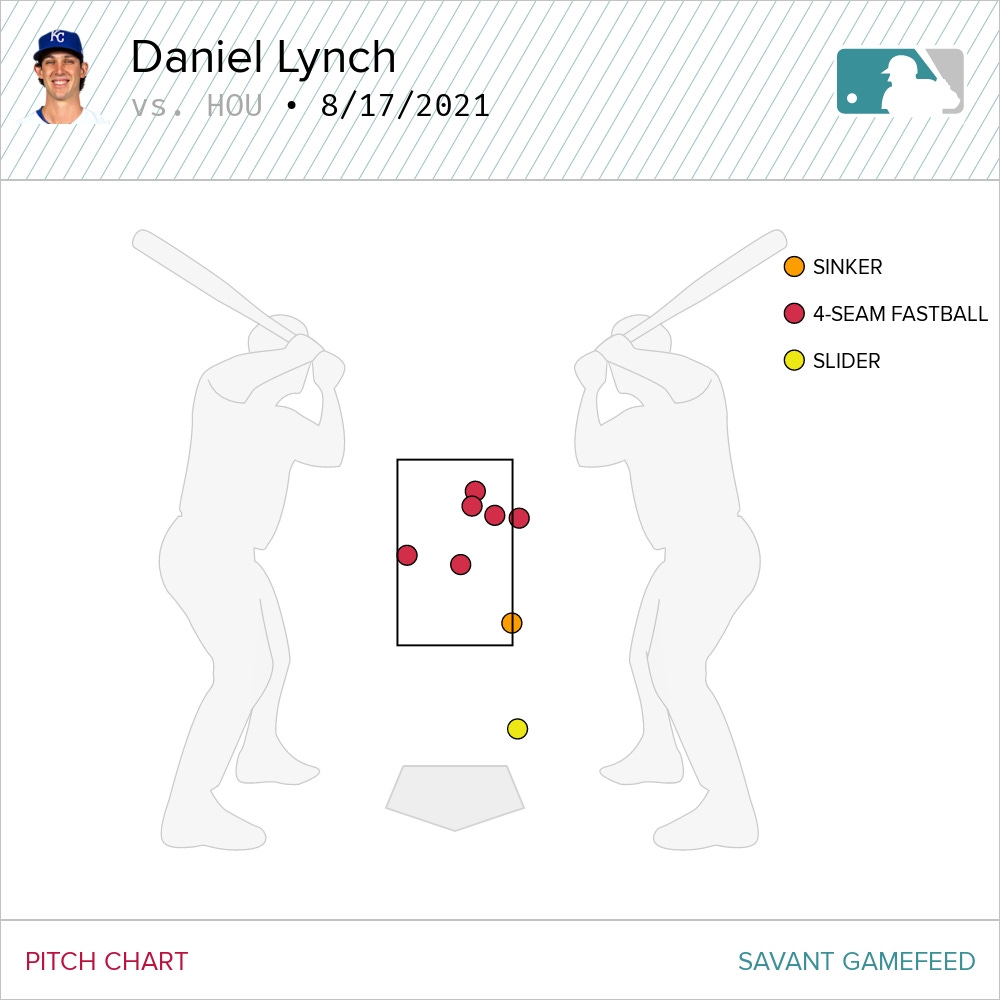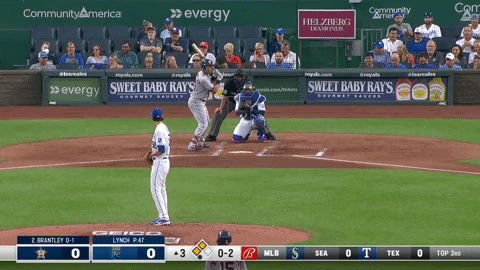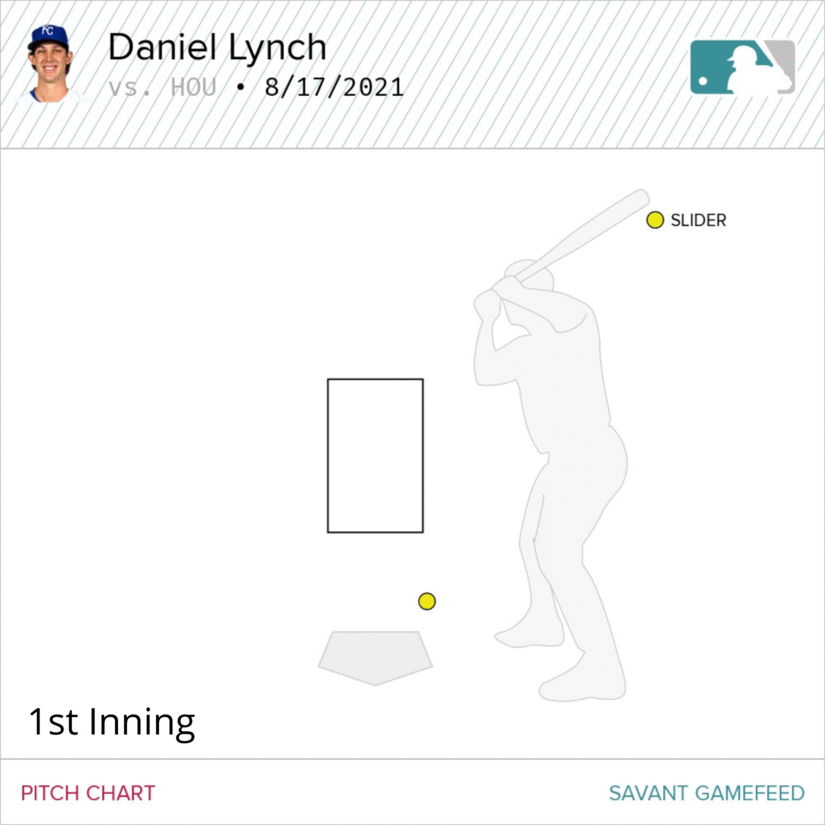Daniel Lynch Aces Another Difficult Test
The rookie lefty shut down the best offense in the American League for seven innings.
Since coming back from the minors on July 25, Daniel Lynch has faced the Tigers, Blue Jays, White Sox, Yankees and now the Astros. That is, as I called it on Twitter last night, an absolute gauntlet. You might think putting the Tigers there is a mistake, but they’ve averaged 5.1 runs per game since mid-June. Anyway, it’s a heck of a run of good offenses he’s had to face, and while he hasn’t been perfect, it’s been really impressive watching him work. But in his last two starts, he’s struggled to get deep into the game, going just five innings and then 4.2 innings, so I was really curious to see what Lynch would do coming off two starts that weren’t exactly great.
He came out of the gates with a great first inning results-wise, taking just eight pitches to get Jose Altuve, Michael Brantley and Carlos Correa 1-2-3. But it was deceiving. The softest hit ball was 103.7 MPH from Altuve. They were all grounders, but the Astros definitely were seeing the ball well from Lynch. He threw six four-seamers, one sinker and one slider. I’m just noting that for a point later, everyone. It’s a classic writing technique, so just roll with it. He caught a lot of the plate with his fastballs, so it’s not really a surprise that the Astros were on them.
In the second, things started off rough with a walk to Aledmys Diaz, but then he got Yuli Gurriel to ground into a double play. He hit a sinker very hard, 103.5 MPH, but again it was a grounder and it worked out very well. He then gave up a hard double on a four-seamer to Chas McCormick. To this point in the second, he’d thrown four four-seam fastballs, three sinkers, four sliders and two changeups. The only pitch that really seemed to be working was the changeup. So after starting 1-1 on Taylor Jones, he threw two straight changeups that were basically perfect.
Then in the third, that’s when the tide turned. It was a bad start to the inning. Jake Meyers hit a hard double on a four-seam fastball. Martin Maldonado walked on a slider that Lynch couldn’t get Maldonado to bite on. So with two on and nobody out and the lineup turning over for a second time through, Lynch really had to get to work. You might remember back to his very first start against the Indians that I thought he did his best work with his back against a wall. And now with some actual success under his belt, he had to do the same thing against the best offense in the game.
He was continuing to try to work with the hard stuff and his slider against Altuve, but it was 2-1 before he went to his changeup on a pitch that Altuve probably should have fired on. Ultimately, Lynch made a great pitch to get a weak grounder from him to third. It was the first batted ball hit at a lower exit velocity than 103.5 MPH and the irony of baseball is that it was the one he probably wanted to be hit a bit harder to give them a chance for a double play. But the runners moved up and the Royals brought the infield in for Michael Brantley, which seemed dangerous.
Brantley came into the game was a 13.2 percent strikeout rate against lefties. He hung a slider on the first pitch and got lucky that Brantley fouled it off. He got two more fouls before throwing his best slider of the game.
The slider simply wasn’t there for him. He couldn’t control it. The Astros weren’t hitting it, but it wasn’t good. It sure felt like he found it on that pitch.
Through the third inning, eight of his first 13 sliders were either left over the plate or off the plate arm side. That’s a pitch that should move enough that it gets pretty deep glove side. Where that pitch ended up to Brantley is a really great spot provided it gets enough movement and looks like a strike long enough. But after leaving so many arm side, just three of his next 14 sliders were in spots he probably didn’t want them. That was quite a turn for him and his slider.
Next up was Correa, and I thought Lynch made just a fantastic pitch to him on a 1-0 count. It was a four-seam fastball just off the plate and in, but Correa is a good hitter and he found a way to get around on it and hit a soft single to center. Again, if he hits the ball a bit harder, it probably carries to Michael A. Taylor and the inning is over, but luckily for both Lynch and the Royals, Taylor was out there and Maldonado was the runner on second because the Astros continued to run into outs.
From that point forward, Lynch really seemed in total control. He found his slider and paired it with a changeup that I think was the best he’s thrown all season. After allowing the first six batted balls to be hit over 100 MPH, just two of the next nine were hit that hard. He was mixing pitches and looking really, really good. From the fourth through the seventh, the Astros went 0-2 on the changeup with one strikeout, 0-2 on the sinker, 1-3 on the four-seam fastball, 0-4 on the slider with two strikeouts and 0-1 on the knuckle curve.
It was like getting into that jam in the third sort of forced him into finding his slider, which turned his entire outing from being on the brink of a disaster to being absolutely fantastic. I thought his location was the absolute best in the sixth and seventh innings.
Sixth:
Seventh:
Look at him staying out of the middle of the zone. When he finally got everything working, it was like the Astros just had no answers for him. In all, he gave up just one run on four hits over seven innings. He struck out five and walked three, which isn’t a great ratio but I don’t think it told the whole story of how good he was.
His fastball was still a bit of an issue. He only had one whiff on 16 swings, but he got much weaker contact as the game went on. He ended up with a 36 percent whiff rate on his slider and 55 percent on his changeup. I told you it was nasty.
And now, in those five games I mentioned above, these are Lynch’s numbers:
30.2 IP
24 H
8 R
8 ER
24 K
11 BB
2.35 ERA
You’d love to see some more strikeouts, but I’m not really sure what else you could ask for here. If the Royals stay on their six-man rotation, he’ll get the Astros again in Houston. That’ll be an even bigger test, but I’m very excited to see how he handles it.
The Royals wrapped it up with straight fire out of the bullpen from Josh Staumont and Jake Brentz. Staumont was very encouraging, hitting 100.2 MPH with his fastball for the first time in forever and he got three whiffs in six swings on it. Brentz was a little wild, walking two, but he got his fastball up to 99.6 MPH and picked up his second save.
And that save was made possible because of two hits with two strikes and two outs. In the third, Taylor doubled down the line to tie the game.
And then in the sixth, Hanser Alberto was facing an 0-2 count with runners on second and third and took a curve ball down the left field line to plate Andrew Benintendi and Hunter Dozier.
Before that double was what I think was a mental error by Correa and the Astros. Taylor hit a grounder up the middle with runners on first and second and it really seemed like Correa had a play at second. Admittedly it was a tough angle and I guess there was no guarantee he could get the out while he knew he could get Taylor, but it really seemed like he gave up on that play. Taylor may have scored from first on Alberto’s double, but he may not have while Hunter Dozier easily scored from second.
It was just another in a long line of mistakes the Astros have made in this series. I talked yesterday about the outs on the bases, letting Nicky Lopez steal second uncontested and Diaz giving up on even getting in a rundown. Last night, Maldonado trying to score on the Correa single in the third seemed like a terrible decision. There were two other choppers to first where nobody covered the bag and the Royals got hits. And then there was that play. I haven’t watched enough Astros games to know if they’re always this sloppy or if they’re playing down to their competition, but I haven’t been impressed with their efforts the last two nights. It makes it tough for me to think they can succeed in the postseason even with all that firepower.
Crown Jewels
Free Agent Follies
I’m a little late in discussing this, but I totally missed this article on Fangraphs last Friday about free agent value and the Royals actually fare surprisingly well. Among players who are new to their teams in 2021 from 2020, the Royals have actually accumulated the fourth most fWAR (at least as of Friday) at a little under 4 fWAR. That includes Mike Minor (1.8), Michael A. Taylor (1.2), Carlos Santana (0.78), Hanser Alberto (0.3), Ervin Santana (-0.1) and Wade Davis (-0.3). So obviously on the pitching side, it hasn’t been quite as good with a couple misses in the bullpen, but the free agent work hasn’t really been terrible. The big miss in free agency for the Royals isn’t so much in the players they signed but in not moving them at the deadline when they were out of the race.
We’ve all talked about this ad nauseam, but I can’t imagine there wasn’t a market for Minor or Santana or especially Taylor. This isn’t something that people especially want to hear, but the value Taylor has given the Royals for the price has been phenomenal. On a one-year deal for $1.75 million to play the kind of defense he has played has been worth every penny. While he’s been pretty bad offensively, he’s been at least competent for a fair amount of the season. He’s miscast as an important piece in a lineup, but on a team like the Astros, he’d be perfect to plop at the bottom of their order and just let him play great defense and hit the occasional home run for them. Either way, I was surprised to see how well the Royals did in free agency compared to the other teams.
Prospects Rising
This is also something I didn’t talk about yesterday, though I didn’t miss it. Baseball America finally released their midseason organizational rankings and as I started scrolling the page, I realized I missed the Royals. But how could that be? They weren’t anywhere from 8-12 and then not from 13-16 as I continued to scroll. Surely they weren’t ranked that low, right? Oh no, they were not. I just totally missed them at third. I don’t follow enough systems to know if that’s aggressive or about right, but I do know that the Mariners and Orioles, the two systems ahead of the Royals, are very good. A lot of the rise has come from the offensive prospects developing. Of the Royals six top 100 prospects, three of them are hitters - Bobby Witt Jr., Nick Pratto and MJ Melendez, so that’s a good sign.
The three arms - Daniel Lynch (who will graduate from the list relatively soon now), Asa Lacy and Jackson Kowar - have all been disappointing in various ways this season, but I think it’s obvious that they’re still all highly respected in the prospect community in spite of their various struggles. The good news here is that of those six, all but Lacy are currently playing in AAA or above, so help is close on the way. I can see a world where all of them are replaced with other prospects in the next year or two, maybe not exactly where they currently sit, but guys like Michael Massey, Nick Loftin and Darryl Collins could all be a top 100 prospect at some point. Pitchers like Alec Marsh, Jon Heasley and Angel Zerpa could make the list. Obviously maybe none of those guys, but the Royals do seem to have a nice pipeline building throughout the system, which we didn’t see with the last wave. It’s pretty normal to be prospect dreaming in mid-August of another bad season, but I really do like what’s on the way.














Those Lynch down-and-in changeups/sliders to the right-handed Astros batters made me feel tingly inside.